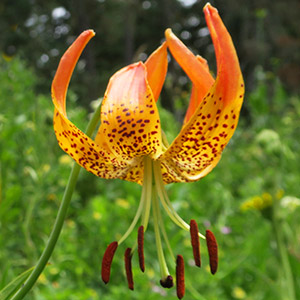Lilium pardalinum
Lilium
leopard lily
lily
in 1–8 whorls or sometimes scattered, 4–27 cm, generally elliptic; less often linear;
margin generally not wavy.
primarily cauline, mostly whorled (often some scattered), sessile; horizontal; and drooping at tips to ascending, generally more or less elliptic;
veins generally 3;
stipules 0.
flowers 1–28(35), pendent.
flowers axillary, 1–45 or more;
bracts generally 2 per flower.
more or less widely bell-shaped, generally not fragrant;
perianth segments 3.4–6.1(7.1)cm;
distal 67–75% potion reflexed, generally 2-toned;
inner surface generally pale orange to red on distal 25–60% portion; lighter near base; maroon spots (if near tip) margined yellow or orange;
outer surface paler and green on basal 20% portion;
stamens longer than perianth;
filaments spreading more or less widely;
anthers 5–22 mm; magenta to orange or yellow, becoming darker;
pollen red-brown to yellow, becoming lighter;
pistil 3–7.6 cm.
generally radial, generally bell- or trumpet-shaped;
perianth segments 6; in 2 petal-like whorls, commonly lanceolate and narrowed at base, generally red-purplespotted on inner base;
stamens 6;
anthers attached near middle;
style 1;
stigma 3-lobed.
2.3–6 cm.
capsules; erect, generally smooth; loculicidal.
many; flat, triangular; in 6 stacks.
=24.
Lilium pardalinum
Lilium
California and southwestern Oregon. 5 subspecies; 4 subspecies in Oregon.
The subspecies of Lilium pardalinum display a classic pattern of discrete geographical ranges with intervening zones of introgression, and no two occur sympatrically without intermixing. Plants in the hybrid zones are confusing in appearance and cannot readily be assigned to subspecies; however, each is fairly well marked within its core distribution. L. pardalinum subspecies in Oregon can be fairly common plants in the proper habitats within their rather narrow distributions, but since all are restricted to wetlands of one type or another, distribution is never continuous across the landscape. In introgression zones, plants often show indicators of genetic instability that include flowers lacking stamens or with shrunken and deformed anthers, filaments, or even petals. Leaf size and shape are quite variable in Lilium pardalinum subspecies and often clearly dependent on environment. In species or populations that typically have narrow, ascending leaves, for example L. pardalinum ssp. vollmeri, shaded plants often have wide, horizontal leaves. This hampers taxonomic separation as well as identification, especially of herbarium specimens. In addition to flower size, color, and habitat, anther size and the degree of stamen exsertion and spread are helpful characters for subspecies identification. Lilium pardalinum is primarily pollinated by western tiger swallowtails and pale swallowtails; in Oregon, Anna’s and rufous hummingbirds are also important visitors, especially when butterflies are rare. Native Americans reportedly ate Lilium pardalinum bulbs steamed or baked in an earth oven (Moerman 1986).
Worldwide in north temperate zone, and tropical mountains of Asia (India, Philippines). Approximately 100 species; 6 species treated in Flora.
Several Lilium taxa have been mistakenly reported to occur in Oregon. Various subspecies of Lilium pardalinum have been misidentified as Lilium parvum, Sierra tiger lily, but the latter drops out north of Lake Tahoe in California, about 200 miles from Oregon. L. rubescens, redwood lily, makes a fairly close approach to Oregon, though the nearest I have seen it is near Forks of Salmon in Siskiyou County, CA, about 50 miles from the state line. A number of specimens at the Oregon State University Herbarium—most from the Dead Indian Plateau in Jackson County—were previously annotated as L. rubescens; all proved to be L. washingtonianum ssp. purpurascens. Cascade lily is distinguished from L. rubescens by its more robust stature and larger flowers [(5.6)6.2–9.4(10.5) vs. 4.2–6.4 cm] which are held horizontally rather than ascending to erect, and by nocturnal nectar and heavy scent production associated with sphingid (hawkmoth) pollination. Within-species variation in North American Lilium is significant, and specific and subspecific boundaries are loose; hybridization is common, particularly where humans have altered natural barriers to gene flow (Skinner 2002). Many Lilium species are declining from habitat destruction and collecting; only a few thrive in gardens. In Oregon, most flower between June and August, with a strong peak in July. Deer crave most liliaceous plants including Lilium, and cattle can eliminate them. This treatment is primarily field-based, and all measurements are from live material. In bulb scale descriptions, 1-segmented = unsegmented, i.e., consisting of a single segment. Anther measurements are after dehiscence and are highly variable due to anther shrinkage.
Mark Skinner
Mark Skinner




